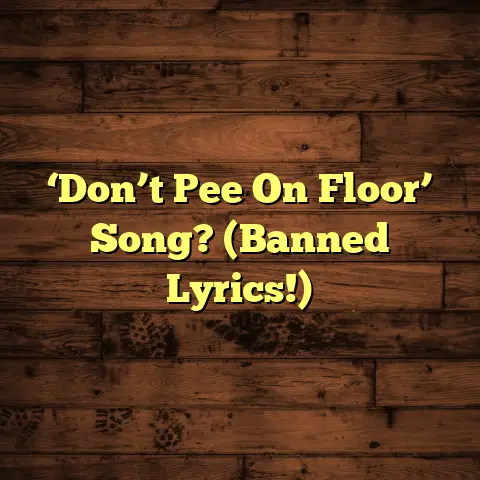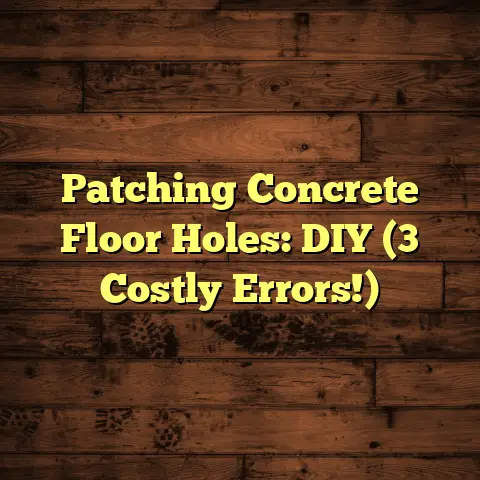Ammonia on Hardwood? Read This! (2 Problems)
Hardwood flooring. It’s the bedrock of so many beautiful homes. As a flooring contractor, I’ve seen firsthand how much homeowners love the warmth and timeless elegance it brings.
We choose hardwood for its durability, its ability to withstand years of foot traffic, kids playing, and even the occasional pet mishap. But maintaining that durability? That’s where things can get tricky.
See, hardwood isn’t invincible. And one of its biggest enemies is something you probably have under your kitchen sink right now: ammonia.
I’m going to break down the specific problems ammonia can cause, and how to keep your floors looking their best for years to come.
Section 1: Understanding Ammonia
Let’s get down to basics. What is ammonia, anyway?
Ammonia is a chemical compound of nitrogen and hydrogen (NH3). It’s a colorless gas with a really strong, pungent odor. Think of that eye-watering smell you get when you open a bottle of strong cleaner.
It’s a workhorse in the cleaning world because it’s super effective at cutting through grease, tackling stains, and neutralizing odors.
Ever wonder why so many commercial cleaners tout their ammonia-powered cleaning? It’s because it works! It’s inexpensive and does a decent job on many surfaces.
Even some products marketed specifically for hardwood floors contain ammonia. That’s where the danger lies. You see, the benefits don’t outweigh the damages on hardwood floors.
Section 2: Problem 1 – Damage to the Finish
Okay, so here’s the first major issue: ammonia can wreak havoc on your hardwood floor’s finish.
Think of the finish as your floor’s armor. It’s the protective layer that shields the wood from scratches, spills, and everyday wear and tear. Most hardwood floors have a finish like polyurethane, lacquer, or varnish.
Now, what happens when ammonia meets these finishes?
Well, ammonia is an alkaline substance. When it comes into contact with acidic finishes like polyurethane, it can break down the chemical bonds that give the finish its strength and resilience.
It essentially starts to dissolve the finish!
What are the signs of finish damage?
- Dullness: The floor loses its shine and appears lackluster.
- Cloudiness: A hazy film develops on the surface.
- Discoloration: You might notice white spots or a yellowish tinge.
I’ve seen this happen time and time again. Homeowners call me in, frustrated because their once-beautiful floors now look faded and worn, after they used ammonia-based cleaner on it.
I remember one client, Sarah, who was meticulous about cleaning. She used a popular “hardwood floor cleaner” religiously, not realizing it contained ammonia.
Over time, her floor’s finish became cloudy and started to peel. The cost to repair the damage was significant.
I know you might be thinking, “Is there any scientific backing for this?” Absolutely!
According to a study published in the “Journal of Coatings Technology and Research,” ammonia-based cleaners can significantly reduce the gloss and hardness of polyurethane coatings on wood surfaces. The study showed that even short-term exposure to ammonia can lead to visible damage. Journal of Coatings Technology and Research
| Finish Type | Exposure to Ammonia | Observed Damage |
|---|---|---|
| Polyurethane | Short-term | Reduced gloss, surface cloudiness |
| Lacquer | Long-term | Softening of the finish, discoloration |
| Varnish | Repeated | Cracking and peeling |
Section 3: Problem 2 – Warping and Structural Integrity
Now, let’s talk about an even more serious problem: warping and structural damage.
Wood is a natural material, and it’s porous. This means it absorbs moisture.
Ammonia, especially when mixed with water, can penetrate the wood fibers. This excess moisture causes the wood to swell. When the wood dries, it shrinks.
This constant swelling and shrinking can lead to warping.
Think of it like repeatedly bending a paperclip. Eventually, it loses its shape.
What are the long-term effects of warping?
- Gaps between boards: Unsightly gaps appear as the wood pulls away from itself.
- Compromised stability: The floor becomes uneven and may even start to creak or buckle.
I had another client, Mark, who used an ammonia-based cleaner to mop up a pet accident. Over time, the boards in that area started to cup and warp.
He ended up having to replace a significant section of his flooring.
It’s not just softwoods that are vulnerable. Hardwoods like oak and maple can also be affected, although the damage may be less pronounced initially.
However, repeated exposure to ammonia will eventually take its toll on even the toughest hardwood.
Anecdotal evidence from flooring professionals suggests that ammonia can accelerate the breakdown of lignin, a complex polymer that provides rigidity to wood.
When lignin is compromised, the wood becomes more susceptible to moisture damage and warping.
Section 4: Prevention Strategies
So, how do you protect your hardwood floors from the dangers of ammonia?
The first step is simple: read the labels!
Before you use any cleaning product on your floors, take a close look at the ingredients. If you see ammonia listed, steer clear.
But what about those “hardwood floor cleaners” that contain ammonia?
Honestly, I wouldn’t risk it. There are plenty of safe and effective alternatives.
What are some alternative cleaning methods?
- Plain water: For light cleaning, a damp mop with plain water can often do the trick.
- pH-neutral cleaners: Look for cleaners specifically formulated for hardwood floors that are pH-neutral. These won’t damage the finish.
- Vinegar solution: A diluted solution of white vinegar and water can be effective for removing dirt and grime.
Regular maintenance is also key. Sweep or vacuum your floors regularly to remove dirt and debris that can scratch the finish.
Wipe up spills immediately to prevent them from soaking into the wood.
Consider using rugs or mats in high-traffic areas to protect the floors from wear and tear.
Section 5: Conclusion
Hardwood flooring is a beautiful and durable investment.
But like any investment, it requires proper care and attention.
Understanding the potential risks of using ammonia-based products is crucial for preserving the beauty and integrity of your floors.
While ammonia might seem like a quick and easy cleaning solution, the long-term damage it can cause simply isn’t worth the risk.
Choose safer alternatives, practice regular maintenance, and your hardwood floors will continue to grace your home for years to come.
So, are you ready to ditch the ammonia and embrace a healthier cleaning routine for your hardwood floors? I hope so! Your floors (and your wallet) will thank you.





